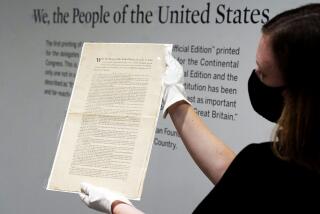Rare Botticelli portrait could fetch more than $80 million at auction
- Share via
NEW YORK — An enigmatic painting from Renaissance master Sandro Botticelli will go on auction next year, with the art world watching to see if it fetches more than $80 million despite the economic slump caused by the COVID-19 pandemic.
“Young Man Holding a Roundel,” Botticelli’s 15th century portrait of a nobleman, is the highlight of Sotheby’s Masters Week sale series in New York in January.
“Just the sheer beauty of this has been a joy,” said Christopher Apostle, who has handled Old Masters at the auction house for more than three decades. “I can’t think of a Botticelli like this that’s been on the open international market.”
Opportunities to acquire a Botticelli — the artist behind such masterpieces as “The Birth of Venus” and “Primavera” — are very rare.
“The fact that there are 12 known portraits by Botticelli puts it in an elite type of situation,” said Apostle. “These are the most personal things he produced, in a way. It’s just something he’s doing with one individual.”
The auction house believes that bids could exceed $100 million. The last painting to achieve that level at auction was Claude Monet’s “Meules” at Sotheby’s in 2019, which went for $110 million.
‘Rockefeller Madonna’ by Botticelli fetches $10.4 million
If it reaches those dizzying heights, it would represent a windfall for the present owner. The painting was last acquired at auction in 1982 for 810,000 British pounds, or slightly more than $1 million at today’s exchange rate.
Apostle doesn’t think that the COVID-19 pandemic will depress interest in the work. “We’ve seen even during this time period that people are hungry for art, hungry for masterpieces, always,” he said.
The painting, believed to have been executed in the late 1470s or early 1480s, actually represents two artworks. Botticelli painted the aristocratic sitter, but the roundel — a circular disc used as a symbol — that the man is holding depicts a saint and is an original 14th century work attributed to the Sienese painter Bartolommeo Bulgarini.
The identity of the sitter has been lost to history, as well as the reason why he is holding the roundel. Some scholars believe he is associated with the ruling House of Medici or another powerful family in Florence.
Make the most of L.A.
Get our guide to events and happenings in the SoCal arts scene. In your inbox every Monday and Friday morning.
You may occasionally receive promotional content from the Los Angeles Times.
Apostle said that some things can be inferred from the young man’s hairstyle, which is long and fashionable for the time, and his tunic, which is buttoned up and restrained.
“There’s a rectitude to this picture and a lack of arrogance while still being very confident that I think exemplifies that attitude that these republicans in Florence felt about themselves,” he says. “Also, by presenting this medallion, he’s just making sure we’re aware he’s a cultivated person.”
In the past 50 years, the painting has spent extended periods on loan at the National Gallery in London, the Metropolitan Museum of Art in New York and the National Gallery of Art in Washington.
More to Read
The biggest entertainment stories
Get our big stories about Hollywood, film, television, music, arts, culture and more right in your inbox as soon as they publish.
You may occasionally receive promotional content from the Los Angeles Times.









